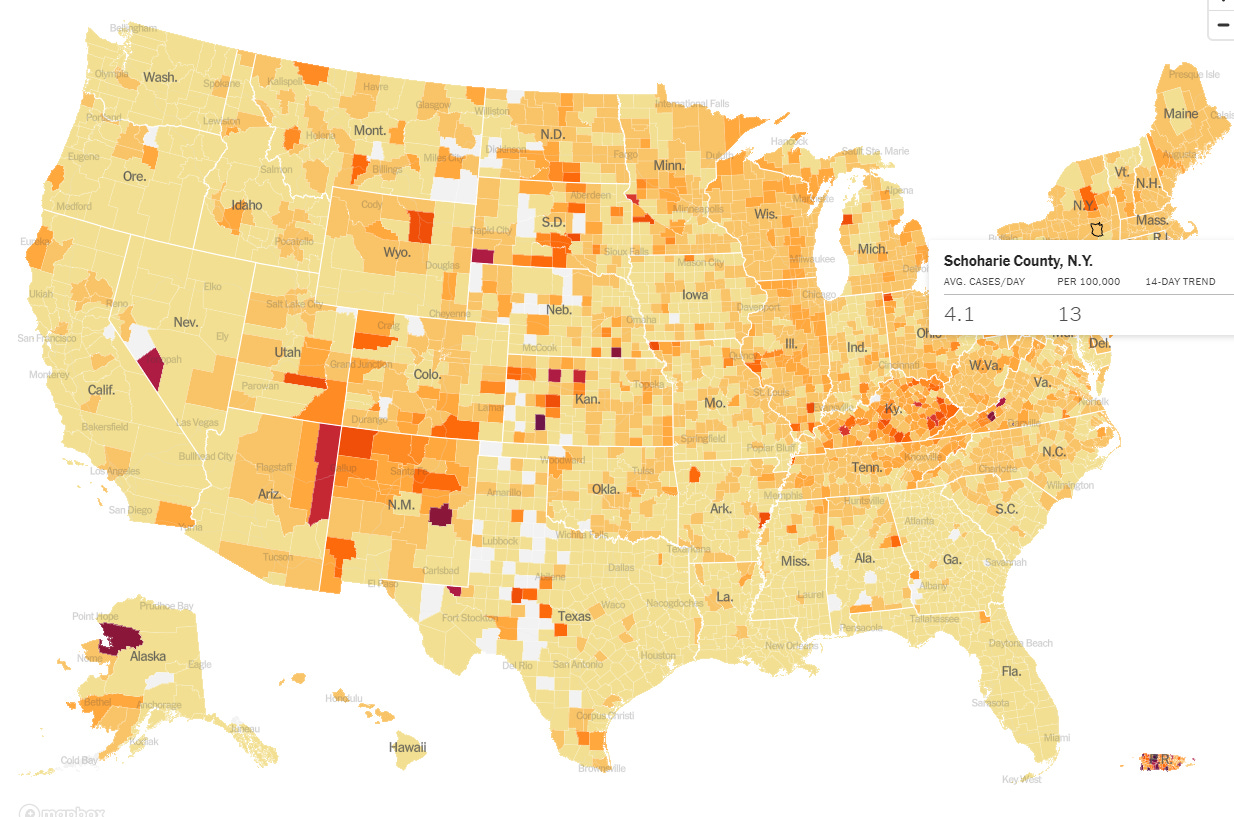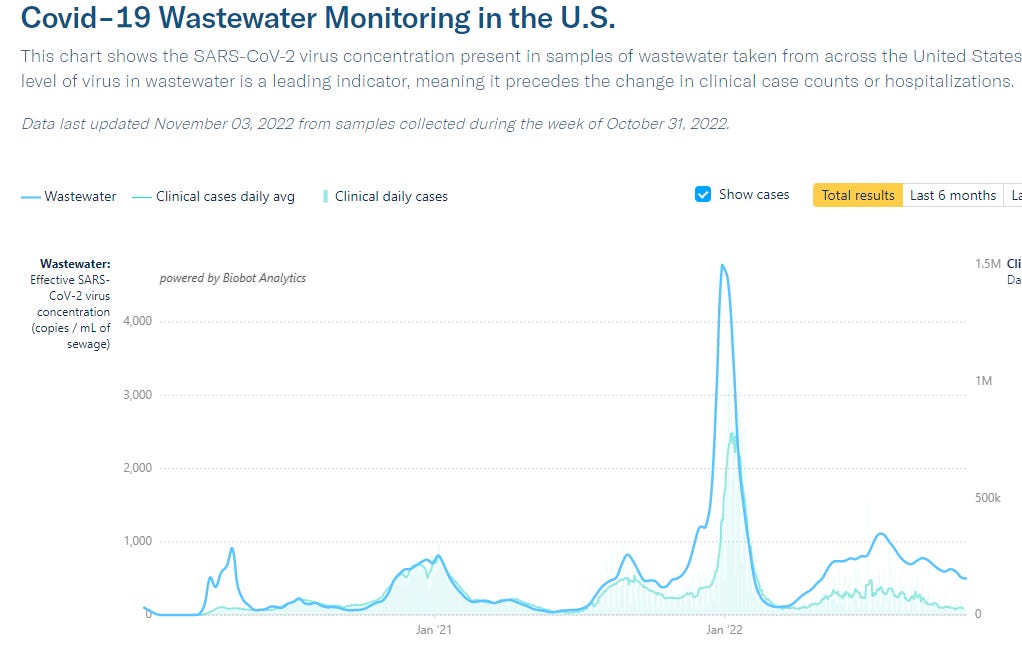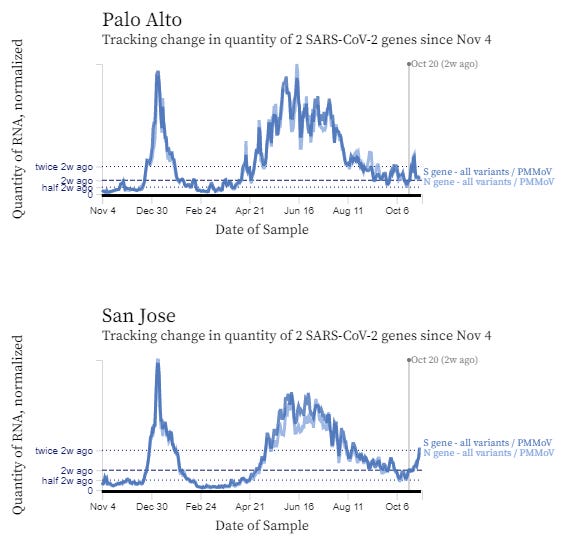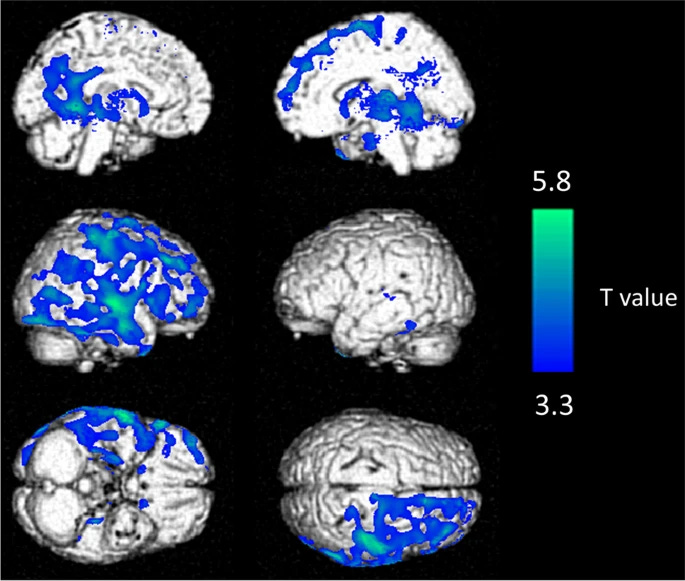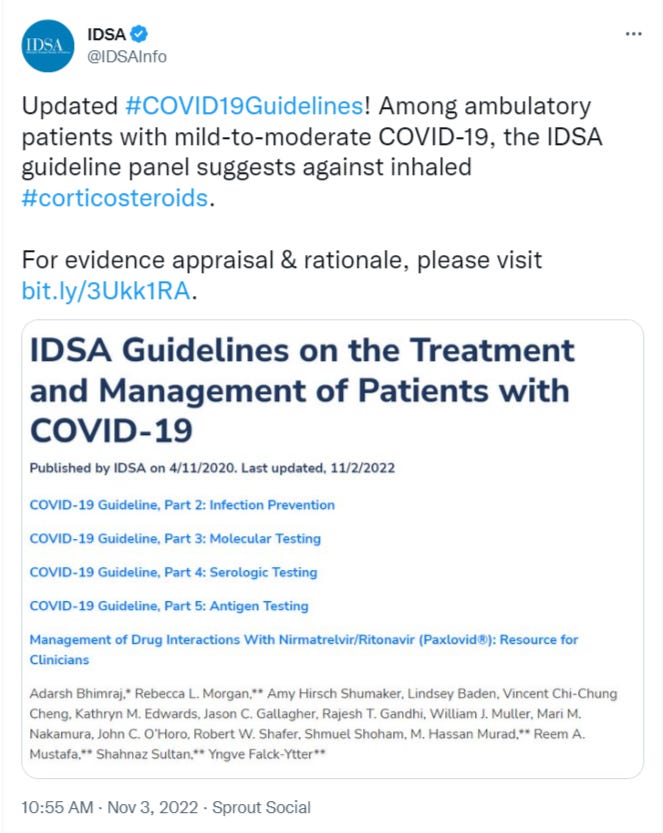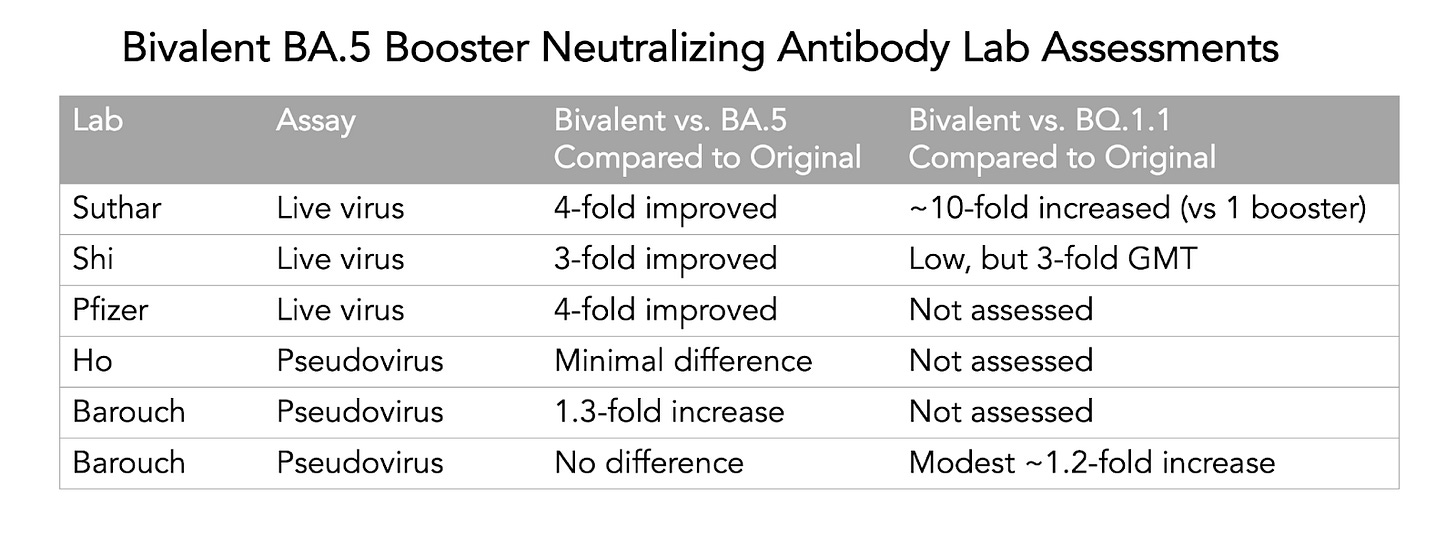COVID news 11/4/22
Hi all,
The BQ.1(1) variants now make up 35% of the SARS-CoV-2 variants in the United States, up from 27% last week. In US Region 2 (which includes New York), BQ.1 and BQ.1.1 make up over 50% of cases. Over 50% of cases in France are also BQ.1(1) and we are seeing that cases in France have peaked and are coming down as are hospitalizations. Cases in Singapore (XBB predominant), France (BQ.1.1 predominant) and most European countries (BA.5 predominant) have peaked and are decreasing now.
BQ.1(1) was found to be extremely immune evasive in lab testing, but fortunately, clinically BQ.1(1) is not causing the hospitalizations and cases that we had feared in places like France. Our collective “immunity wall” is complex and is made of immunity that we acquire from vaccinations, boosters and infections.
Thanksgiving will be here soon in the US and Katelyn Jetelina has some great advice for making our holidays safer this year. As mentioned previously, all of the “usual viruses” like influenza, rhinoviruses, enteroviruses and RSV are back in full force very early in the season. In order to protect loved ones who may be more at risk (grandparents, young babies, immunosuppressed friends and family), it is important to get the bivalent booster vaccine if you haven’t already gotten it, get the flu shot (this year’s shot is well matched to the main influenza virus circulating), wear N95 or KN95 masks if you go indoors for the week prior to the holiday event and finally, test 2 days prior to the event and again a few hours before the holiday event with a rapid antigen COVID test. KJ also recommends that if you have cold symptoms or feel unwell, you should probably skip going to the holiday event even if you test negative for COVID, as you could have the flu or another illness that you could inadvertently spread to others.
Ohio and Wisconsin have fairly high wastewater virus levels this week again. Michigan, Colorado and Utah are mixed. California, Oregon, Missouri and Texas have low levels of SARS-CoV-2 virus seen in wastewater this week.
There have been 6 new studies on the human response to the bivalent booster in the last two weeks. The three studies that used live virus in their assays showed that the bivalent booster protected better against BA.5 than the monovalent booster did, in that the bivalent booster (WT + BA.5) stimulated more neutralizing antibodies against BA.5. The bivalent booster also was found to increase neutralizing antibodies against BQ.1.1 and BA.2.75.2 which is reassuring.
Boosters, in general, have been shown to decrease hospitalizations and decrease deaths from COVID infections in people over age 50. A new study shows that booster shots increase neutralizing antibodies well, but T cells remain stable over time after complete vaccination with no significant effect of booster vaccination on T-cell responses and cross-recognition of Omicron BA.1 and BA.2 mutations.
There were 3 interesting articles on Long COVID this week. First, an article in Bloomberg discusses five women who are helping crack the Long COVID mystery. The article reviews clinical trials using different medications including anti-inflammatory medicine colchicine, Xarelto (an anti-blood clotting drug), Famotidine (aka Pepcid, an H2 blocker) and Loratadine in addition to Ivabradine (repurposed heart failure medication) and finally steroids and IVIG. Hopefully some of these repurposed drugs will be found to help Long COVID patients.
A new book called the “Long COVID Survival Guide” is coming out this week. It was written by people who have Long COVID and those who treat Long COVID patients with expert advice on getting diagnosed, dealing with symptoms, accessing resources and accommodations for Long COVID. And finally, there was an article on brain hypometabolism in Long COVID. Long COVID patients who had mild COVID infections initially, were found to have HYPOmetabolism of glucose in the right frontal lobe and temporal lobe of the brain. People who had more symptoms at the time of COVID infection had low brain metabolism more than a year after their initial infection. People with Long COVID who had persistent weakness and language disorders at 16 months post-acute COVID infection also had lower brain metabolism in the frontal and temporal lobes of the brain. In order to successfully treat Long COVID, we need to understand all of the causes of Long COVID.
Have a good weekend and please remember to vote!
Ruth Ann Crystal MD
Twitter: https://twitter.com/CatchTheBaby
Other news:
10/31/22 Flu-related hospitalizations highest in 10 years https://buff.ly/3FxrrwG
CDC estimates 880,000 cases of lab-confirmed influenza so far.
H3N2 is the predominant viral strain currently spreading. Previous seasons with mostly H3N2 viruses have been of higher severity, particularly for older adults and young children.
Pediatric hospitals are already filling with RSV this year.
From 1/2017 JAMA but no significant changes:
Respiratory Syncytial Virus (RSV) https://buff.ly/3U6VwaD
From Beena Kamath-Rayne, MD, MPH, FAAP
COVID news:
https://newsnodes.com/worldmonitor/
World
(P.S. The US does not have this many cases now. It may have to do with case reporting happening only weekly now.)
United States
US cases: https://www.nytimes.com/interactive/2021/us/covid-cases.html
https://ourworldindata.org/coronavirus
Variant tracker in US: https://covid.cdc.gov/covid-data-tracker/#variant-proportions
BQ.1(1) is 35% of all variants in US now (BQ.1 16.5% + BQ.1.1 18.8%)
Region 2: BQ.1(1) is 52.3% and so far, hospitalizations are not increasing significantly.
Gerstung-lab: International SARS-CoV-2 Variant surveillance https://buff.ly/3FbG3Bz
Variant rates based on cov-spectrum.org, GISAID, and https://ourworldindata.org/coronavirus
Wastewater Monitoring:
CDC Wastewater Monitor https://covid.cdc.gov/covid-data-tracker/#wastewater-surveillance
Ohio is mostly high virus (red) and Wisconsin is orange and red.
Michigan, Colorado and UT are mixed.
California, Missouri, Oregon and Washington are mostly low level (blue).
Biobot: https://biobot.io/data/
Sewer Coronavirus Alert Network (SCAN) project by Stanford University:
11/3/22 BQ.1.1 in France. Cases and hospitalizations are decreasing.
11/3/22 Katelyn Jetelina: Thinking through the holidays this year https://buff.ly/3T55hEQ
To protect the vulnerable:
Fall booster and Flu shot 3 weeks prior to event
N95 masking in public 1 week prior to event
Home Antigen COVID tests- 2 days before and on the day of the in person event
Omicron infections last longer: average 8 to 10 days (+/-)
At event:
Ventilation, air filters
If you have cold symptoms, stay home. It could be COVID or the flu or RSV or another virus. The "normal viruses" are back now too.
11/3/22 European Journal of Nuclear Medicine and Molecular Imaging (Nancy, France):
Brain 18F-FDG PET imaging in outpatients with post-COVID-19 conditions (PASC, Long COVID): findings and associations with clinical characteristics https://buff.ly/3DX5tBY
The most common radiotracer in use today is 18F-fluorodeoxyglucose (18F-FDG) which is a radiolabeled sugar (glucose) molecule. Imaging with 18F-FDG PET is used to determine sites of abnormal glucose metabolism.
n = 28 consecutive non-hospitalized COVID patients who presented with post-COVID-19 conditions (PASC, Long COVID) between September 2020 and May 2022.
Brain PET scans showed three large HYPOmetabolic clusters in the brains of PASC/Long COVID patients located mostly in the Right Frontal and Temporal lobes,but not seen in healthy controls.
The brainstem and the cerebellum were not involved unlike prior studies that included COVID patients who had been hospitalized.
Hypometabolism clusters were associated with a higher number of symptoms at the time of the initial COVID infection.
Our study identified that longer duration of symptoms was associated with lower metabolism in identified clusters, which suggests that post-COVID conditions are becoming chronic.
Anatomic localization of HYPOmetabolic brain areas in PASC/Long COVID outpatients compared to healthy controls
Asthenia (weakness), cardiovascular and digestive complaints, and neurological disorders at onset were respectively associated with lower metabolic values: Clusters 1, 2, and 3 (p ≤ 0.04), Cluster 1 (p ≤ 0.04), and Cluster 2 (p = 0.01).
Persistent asthenia (weakness) and language disorders were respectively associated with lower metabolic values: Cluster 1 and 3 (p ≤ 0.04) and Cluster 2 (p = 0.02).
11/3/22 PNAS: Anti-PF4 antibodies (anti-Platelet Factor 4) associated with disease severity in COVID-19 https://buff.ly/3UaEIQ7
Almost all patients with severe COVID infections have anti-PF4 antibodies and higher autoantibodies were found in the sickest patients.
High risk for blood clots with severe COVID may be related to this.
Anti-PF4 antibodies are the hallmark of two life-threatening disorders: heparin-induced thrombocytopenia (HIT) and vaccine-induced thrombosis with thrombocytopenia (VITT).
11/3/22 NEJM: Pfizer Covid-19 Vaccine Protection among Children and Adolescents in Qatar https://buff.ly/3DZDRw7
Vaccination in children was associated with modest, rapidly waning protection against Omicron infection.
Vaccination in adolescents was associated with stronger, more durable protection, perhaps because of the larger antigen dose (30 ug vs 10 ug).
10 ug primary vaccine series:
VE 25.7% against Omicron infection
VE was highest 49.6% right after receipt of the second dose but waned rapidly thereafter and was negligible after 3 months.
Kids 5 to 7 years: VE 46.3%
Kids 8 to 11 years: VE 16.6%
30 ug primary series,
VE 30.6% against Omicron infection but many had been vaccinated months earlier.
Effectiveness waned over time since receipt of the second dose.
Effectiveness was 35.6% among adolescents 12 to 14 years of age and 20.9% among those 15 to 17 years of age.
Note: Before Omicron VE of 30 ug primary vaccine series against infection in adolescents was 87.6% and waned slowly. Hopefully, the new bivalent boosters will increase VE against infection.
11/3/22 IDSA
11/3/22 Eric Topol’s Pandemic Daily Update: https://buff.ly/3T5mkXx
Several studies using live virus assays now show that the bivalent booster (WT + BA.5) makes 3-4x more neutralizing antibodies to BA.5 than the original monovalent (WT) booster. Yay!
Also, the Suthar lab report shows that the bivalent booster (WT + BA.5) makes 10x more neutralizing antibodies to BQ.1.1 than the original monovalent (WT) booster. Double yay!
Boosters:
Needed because immunity wanes over time.
Cause >80% reduction of hospitalizations and >90% reduction of deaths in people age 50+.
Bivalent booster increases nAbs to BA.5 three to four times more than the monovalent.
Bivalent booster increases nAbs to BQ.1.1 ten-fold more than the monovalent.
Boosters decrease the risk of Long COVID 10 to 50%.
Ho https://www.biorxiv.org/content/10.1101/2022.10.22.513349v1
Barouch https://www.biorxiv.org/content/10.1101/2022.10.24.513619v1
Suthar https://www.biorxiv.org/content/10.1101/2022.10.31.514636v1
In the BA.5-containing bivalent booster cohort, the neutralizing activity improved against all of the Omicron subvariants (BA.1, BA.5, BA.2.75.2, and BQ.1.1).
11/2/22 Bloomberg: These Five Women Are Helping Doctors Crack the Long Covid Mystery https://buff.ly/3sRfbiU
Long COVID symptoms include exhaustion, rapid heart rate and other bewildering symptoms that suggest the SARS-CoV-2 virus has damaged their nervous systems.
Breakdown of the barrier between the brain and the bloodstream can allow bloodborne proteins to leak into a patient’s brain, triggering dangerous inflammation.
Clinical trials of:
colchicine, an anti-inflammatory
Ivabradine- heart failure medication
steroids and IVIG
Colchicine
Xarelto (anti-clotting medication)
Famotidine and Loratadine H2 blockers
11/1/22 Science: Durable spike-specific T-cell responses after different COVID-19 vaccination regimens are not further enhanced by booster vaccination https://buff.ly/3Wks3M2
Booster shots increase neutralizing antibodies well, but T cells remain stable over time after complete vaccination with no significant effect of booster vaccination on T-cell responses and cross-recognition of Omicron BA.1 and BA.2 mutations.
The immune response gained from booster shots is largely confined to neutralizing antibodies (nAbs) and not T-cells.
11/1/22 Nature: Gut microbiome dysbiosis in antibiotic-treated COVID-19 patients is associated with microbial translocation and bacteremia https://buff.ly/3Dwi1i7
n = 96 patients (60 at NYU, 36 at Yale) with Covid infections
Antibiotic treated COVID infections were associated with disruption of the gut microbiome (dysbiosis) and translocation of gut bacteria into the blood, causing life-threatening secondary infections, including some that were antibiotic resistant.
Altered permeability of the gut lining epithelial cells.
Bacteremia in hospitalized COVID patients is associated with microbiome dysbiosis.
11/1/22 Science: Host protein kinases required for SARS-CoV-2 nucleocapsid phosphorylation and viral replication https://buff.ly/3DRiTzf
Targeting the host instead of the virus.
Human protein kinases SRPK1/2 are important for the replication of viruses, including SARS-CoV-2, hepatitis B virus, human papillomavirus, hepatitis C virus, Ebola virus, human cytomegalovirus, and herpes simplex virus-1.
Alectinib is used clinically to treat non–small cell lung cancer (NSCLC), and also leads to inhibition of SRPK1/2.
But, Alectinib has very serious side effects including liver and kidney injury, bradycardia, hemolytic anemia).
Rodrigo Quiroga- Subvariant descendants of Omicron BA.2
10/31/22 BioRxiV (Yunlong Cao’s lab): Imprinted SARS-CoV-2 humoral immunity induces convergent Omicron RBD evolution https://buff.ly/3NocZsA
Note: Tested in patients with CoronaVac, not mRNA vaccines
More new subvariants that are even more immune evasive.
Convergent mutations can cause striking evasion of neutralizing antibody (NAb) drugs and convalescent plasma, including those from BA.5 breakthrough infection, while maintaining sufficient ACE2 binding capability.
BQ.1.1.10, BA.4.6.3, XBB, and CH.1.1 are the most antibody-evasive strains tested, even exceeding SARS-CoV-1 level.
Current herd immunity and BA.5 vaccine boosters may not provide good protection against infection from these variants.
Broad-spectrum SARS-CoV-2 vaccines and NAb drugs development should be highly prioritized.
The Long COVID Survival Guide by Fiona Lowenstein et al. https://buff.ly/3fmf37T
Available November 8, 2022
10/31/22 Reuters: U.S. CDC director Dr. Walensky experiences COVID rebound after taking Pfizer's Paxlovid https://buff.ly/3zxkqIm
10/30/22 Nature: COVID ‘variant soup’ is making winter surges hard to predict https://buff.ly/3U5kwi0
10/30/22
10/30/22 Nature: Platform for isolation and characterization of SARS-CoV-2 variants enables rapid characterization of Omicron in Australia https://buff.ly/3sHGAnl
Perhaps a bit of propaganda, but he’s not wrong about Long COVID disability affecting the future workforce.
10/30/22 Florida Surgeon General










